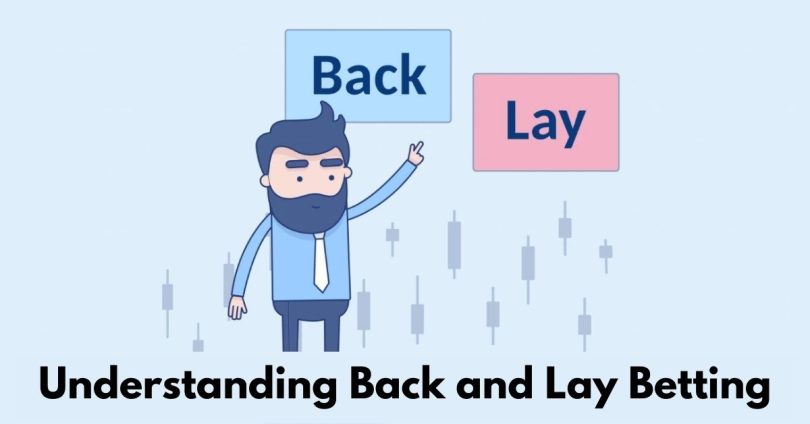Betting strategies come in various forms, but one of the most prominent and widely used is back and lay betting. This form of wagering, common in exchange markets, provides punters with a unique opportunity to take on the role of both the bettor and the bookmaker. This guide will elucidate the concepts of back and lay betting, lay betting, back betting, and more.
Introduction to Betting: Back Betting
Back betting, often referred to simply as “backing,” is the most traditional form of betting. Here, you are betting on a particular outcome to happen. For instance, if you’re backing a team in a football match, you’re essentially betting that this team will win. If your selected team wins, you win the bet. If the team loses or the game ends in a draw, you lose your bet.
Back betting forms the basis of the betting industry, with bookmakers offering odds on certain outcomes, which punters can then decide whether to back or not.
It is used widely in the realm of online gambling, particularly noticeable on betting apps for cricket and betting sites for cricket. ‘Back’ refers to a conventional bet where a gambler predicts that a certain outcome will happen – for example, team A will win a cricket match. If the outcome turns out as predicted, the bet is won. On the other hand, ‘Lay’ is essentially the opposite of a ‘Back’ bet, where the bettor takes on the role of a bookmaker. In a ‘Lay’ bet, the gambler predicts that a particular outcome will not happen – for instance, team A will not win the cricket match. If the outcome is any result other than the one specified in the ‘Lay’ bet, the bet is won. This variety of betting options makes it more interesting and engaging for users of cricket betting apps and sites.
Switching Roles: Lay Betting
Lay betting is a type of wager that is the exact opposite of a back bet. When you place a lay bet, you are essentially betting against a particular outcome. You’re taking on the role of the bookmaker by offering odds on certain events not happening.
For example, if you lay a team in a football match, you’re betting that the team will not win. If the team wins, you lose your bet. However, if the team loses or draws, you win your bet.
Lay betting is a unique aspect of betting exchanges, where punters can offer odds to other bettors. It’s a fascinating twist on traditional wagering that opens up new strategic possibilities.
Bringing Them Together: Back and Lay Betting
Back and lay betting is a strategy that combines these two types of bets. Punters back an outcome at higher odds and then lay the same outcome at lower odds. The aim is to make a profit regardless of the actual outcome.
This strategy is most commonly used in horse racing but can be applied to virtually any sport. The crucial aspect of back and lay betting is timing, as odds can fluctuate dramatically both before the event and in play.
How Does Back and Lay Betting Work?
The process of back and lay betting involves two steps. Firstly, a back bet is placed on a particular outcome, and then a lay bet is placed against the same outcome. The main objective here is to cover all the possible outcomes of an event, thus ensuring a profit regardless of the result.
The challenging part of back and lay betting is finding the right opportunities where the odds make this strategy profitable. A deep understanding of the market, the sport, and odds calculation is crucial for success in back and lay betting.
Advantages and Disadvantages of Back and Lay Betting
The primary advantage of back and lay betting is that it can provide a guaranteed profit if done correctly, irrespective of the event’s outcome. It’s also a flexible strategy that can be used in different types of sports and betting markets.
However, back and lay betting does come with its disadvantages. The strategy requires a good understanding of betting exchanges and odds. It also involves more risk than simple back betting, as you need to cover all potential outcomes. Lastly, if the odds don’t move in the direction you anticipated, you could end up making a loss.
Conclusion
Back and lay betting is a unique and exciting way to approach sports betting. It provides a level of flexibility not found in traditional wagering and can offer the potential for profit regardless of the result of an event. However, as with all betting strategies, it requires understanding, practice, and careful management of risks. Whether you decide to stick with traditional back betting or venture into the world of lay betting and back and lay betting strategies, the key to success lies in careful research, understanding market trends, and prudent risk management.
In the end, it’s not just about picking winners or losers but understanding how the odds are stacked and making informed decisions based on that information. With patience and persistence, back and lay betting can become an important tool in your betting arsenal, potentially leading to more consistent wins and a rewarding betting experience. As always, remember to gamble responsibly and only bet what you can afford to lose.
Frequently Asked Questions
1. How Does Back and Lay Betting Work?
In back and lay betting, firstly, a back bet is placed on a particular outcome, and then a lay bet is placed against the same outcome. The goal is to cover all the possible outcomes of an event, ensuring a profit irrespective of the result.
2. Are There Any Disadvantages of Back and Lay Betting?
Yes, back and lay betting does come with some disadvantages. It requires a good understanding of betting exchanges and odds. It involves more risk than simple back betting as you need to cover all potential outcomes. If the odds don’t move as anticipated, a loss may occur.
3. Can Back and Lay Betting be Used in All Sports?
Yes, back and lay betting can be used in any sport as long as the betting exchange or platform supports it. It’s commonly used in horse racing but can be applied to football, tennis, cricket, and other sports.








